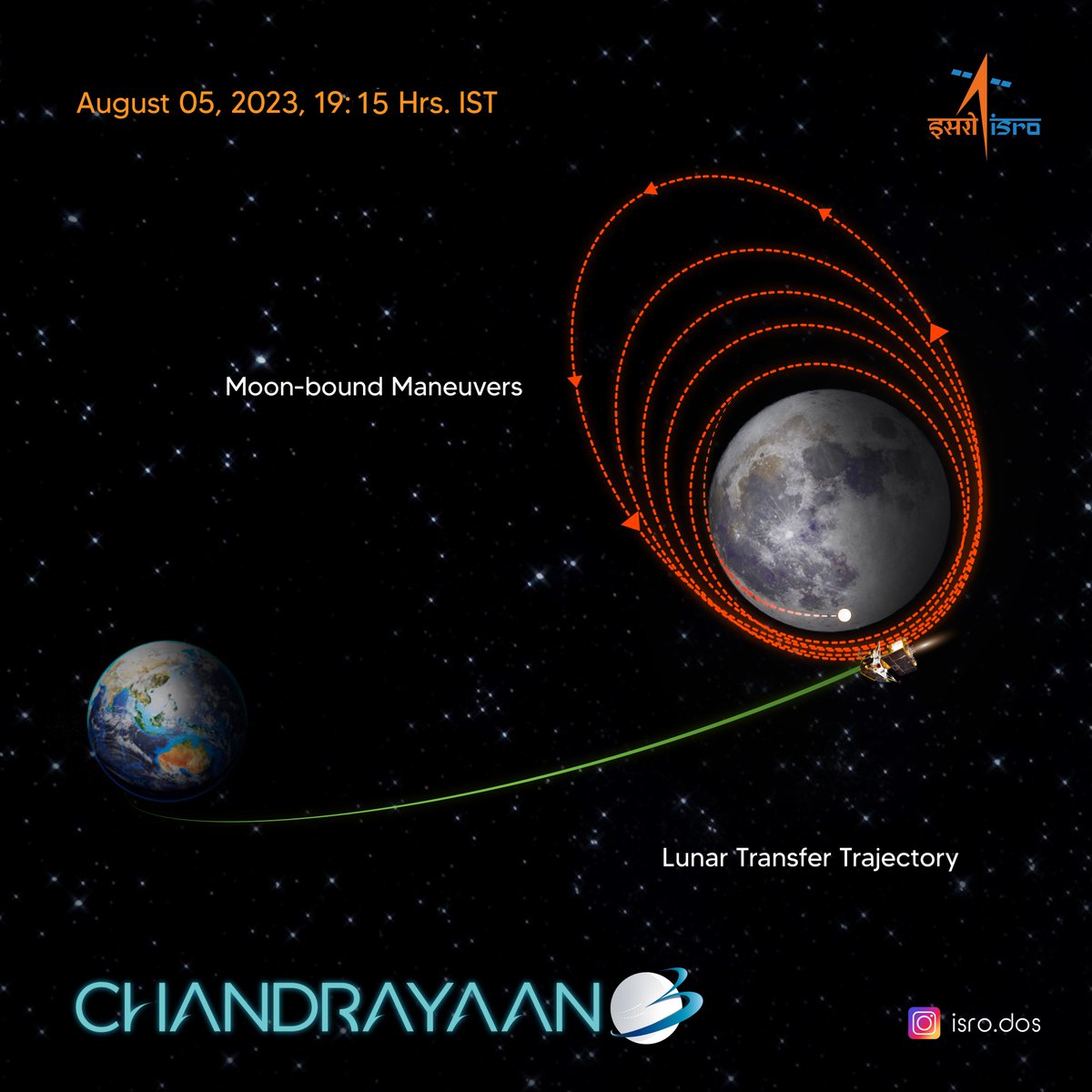ISRO, 7th August 2023:
Chandrayaan-3 space mission enters lunar orbit
India’s space agency says its spacecraft has successfully been inserted into the lunar orbit.
India’s latest space mission, Chandrayaan-3, has entered the moon’s orbit more than three weeks after its launch, the country’s space agency said on Saturday.
Chandrayaan-3 Mission: “MOX, ISTRAC, this is Chandrayaan-3. I am feeling lunar gravity ”
Chandrayaan-3 has been successfully inserted into the lunar orbit. A retro-burning at the Perilune was commanded from the Mission Operations Complex (MOX), ISTRAC, Bengaluru. The next operation – reduction of orbit – is scheduled for Aug 6, 2023, around 23:00 Hrs. IST.

Chandrayaan-3 space mission enters lunar orbit
The Indian Space Research Organisation (ISRO) confirmed that Chandrayaan-3, which means moon vehicle in Sanskrit, had been “successfully inserted into the lunar orbit”.
If the rest of the current mission goes to plan, the mission will safely touch down near the moon’s little-explored south pole between August 23 and 24.
India’s last attempt to do so ended in failure four years ago, when ground control lost contact moments before landing.
MTFE AI Trading Daily Timing | World Wide Timing for MTFE Trade Estimated Profit
Developed by ISRO, Chandrayaan-3 includes a lander module named Vikram, which means “valour” in Sanskrit, and a rover named Pragyan, the Sanskrit word for wisdom.
It is a major milestone for the country that has run its ambitious aerospace programme on a comparatively low budget. Only Russia, the United States and China have previously achieved a controlled landing on the lunar surface.
The mission comes with a price tag of $74.6m – far smaller than those of other countries, and a testament to India’s frugal space engineering.
Experts say India can keep costs low by copying and adapting existing space technology, and thanks to an abundance of highly skilled engineers who earn a fraction of their foreign counterparts’ wages.
The Chandrayaan-3 spacecraft has taken much longer to reach the moon than the manned Apollo missions of the 1960s and 1970s, which arrived in a matter of days.
Chandrayaan-3 Mission:
“MOX, ISTRAC, this is Chandrayaan-3. I am feeling lunar gravity 🌖”
🙂Chandrayaan-3 has been successfully inserted into the lunar orbit.
A retro-burning at the Perilune was commanded from the Mission Operations Complex (MOX), ISTRAC, Bengaluru.
The next… pic.twitter.com/6T5acwiEGb
— ISRO (@isro) August 5, 2023
The Indian rocket used is much less powerful than the United States’ Saturn V and instead the probe orbited Earth five or six times elliptically to gain speed, before being sent on a month-long lunar trajectory.
If the landing is successful the rover will roll off Vikram and explore the nearby lunar area, gathering images to be sent back to Earth for analysis.
The rover has a mission life of one lunar day or 14 Earth days.
How to get started with MTFE Earn Money Online, Work From Home, Part Time Jobs
ISRO chief S Somanath has said his engineers carefully studied data from the last failed mission and tried their best to fix the glitches.
India’s space programme has grown considerably in size and momentum since it first sent a probe to orbit the moon in 2008.
In 2014, it became the first Asian nation to put a satellite into orbit around Mars, and three years later, the ISRO launched 104 satellites in a single mission.
The ISRO’s Gaganyaan (Sanskrit for sky craft) programme is slated to launch a three-day manned mission into Earth’s orbit by next year.
Padma Awards 2024 | Nominations for India’s highest civilian awards #PadmaAwards2024 are live
India is also working to boost its 2 percent share of the global commercial space market by sending private payloads into orbit for a fraction of the cost of competitors.
Chandrayaan-3 Mission:
The spacecraft successfully underwent a planned orbit reduction maneuver. The retrofiring of engines brought it closer to the Moon’s surface, now to 170 km x 4313 km. The next operation to further reduce the orbit is scheduled for August 9, 2023, between 13:00 and 14:00 Hrs. IST.
